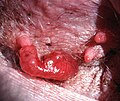Reproductive system
Reproductive system is a system of sex organs within an organism which work together for the purpose of sexual reproduction. Many non-living substances such as fluids, hormones, and pheromones are also important accessories to the reproductive system.<ref>
Reproductive system(link). {{{website}}}.
</ref> Unlike most organ systems, the sexes of differentiated species often have significant differences.
Overview[edit]
The reproductive system involves a number of internal and external organs that work together for reproduction. The major reproductive organs of the female include the ovaries, fallopian tubes, uterus, vagina, and mammary glands. The major reproductive organs of the male include the testes, vas deferens, seminal vesicles, prostate, and penis.
Female Reproductive System[edit]
The female reproductive system is made up of internal organs and external structures. Its function is to enable reproduction of the species. Sexual maturation is the process that this system undergoes in order to carry out its role in the process of pregnancy and birth.
Ovaries[edit]
The ovaries are small, paired organs that are located near the lateral walls of the pelvic cavity. These organs are responsible for the production and release of eggs, or oocytes, for fertilization and pregnancy.
Fallopian Tubes[edit]
The fallopian tubes are a pair of muscular tubes that extend from the left and right superior regions of the uterus to the edge of the ovaries, in the female reproductive system.
Uterus[edit]
The uterus, or womb, is a major female responsive reproductive sex organ of most mammals, including humans.
Vagina[edit]
The vagina is a muscular canal that extends from the vulva to the neck of the uterus (cervix) in women and females of other mammal species.
Mammary Glands[edit]
The mammary glands are specialized organs in mammals that produce milk to feed young offspring.
Male Reproductive System[edit]
The male reproductive system consists of a number of sex organs that play a role in the process of human reproduction.
Testes[edit]
The testes are the male gonads that produce sperm and reproductive hormones.
Vas Deferens[edit]
The vas deferens, also known as the sperm duct, is a thin tube approximately 30 centimeters long that starts from the epididymis to the pelvic cavity.
Seminal Vesicles[edit]
The seminal vesicles are a pair of simple tubular glands posteroinferior to the urinary bladder of some male mammals.
Prostate[edit]
The prostate is a compound tubuloalveolar exocrine gland of the male reproductive system in most mammals.
Penis[edit]
The penis is a part of the male reproductive system that has a shaft and an opening through which sperm and urine exit.
See Also[edit]
References[edit]
<references />
Ad. Transform your life with W8MD's Budget GLP-1 injections from $75


W8MD offers a medical weight loss program to lose weight in Philadelphia. Our physician-supervised medical weight loss provides:
- Weight loss injections in NYC (generic and brand names):
- Zepbound / Mounjaro, Wegovy / Ozempic, Saxenda
- Most insurances accepted or discounted self-pay rates. We will obtain insurance prior authorizations if needed.
- Generic GLP1 weight loss injections from $75 for the starting dose.
- Also offer prescription weight loss medications including Phentermine, Qsymia, Diethylpropion, Contrave etc.
NYC weight loss doctor appointmentsNYC weight loss doctor appointments
Start your NYC weight loss journey today at our NYC medical weight loss and Philadelphia medical weight loss clinics.
- Call 718-946-5500 to lose weight in NYC or for medical weight loss in Philadelphia 215-676-2334.
- Tags:NYC medical weight loss, Philadelphia lose weight Zepbound NYC, Budget GLP1 weight loss injections, Wegovy Philadelphia, Wegovy NYC, Philadelphia medical weight loss, Brookly weight loss and Wegovy NYC
|
WikiMD's Wellness Encyclopedia |
| Let Food Be Thy Medicine Medicine Thy Food - Hippocrates |
Medical Disclaimer: WikiMD is not a substitute for professional medical advice. The information on WikiMD is provided as an information resource only, may be incorrect, outdated or misleading, and is not to be used or relied on for any diagnostic or treatment purposes. Please consult your health care provider before making any healthcare decisions or for guidance about a specific medical condition. WikiMD expressly disclaims responsibility, and shall have no liability, for any damages, loss, injury, or liability whatsoever suffered as a result of your reliance on the information contained in this site. By visiting this site you agree to the foregoing terms and conditions, which may from time to time be changed or supplemented by WikiMD. If you do not agree to the foregoing terms and conditions, you should not enter or use this site. See full disclaimer.
Credits:Most images are courtesy of Wikimedia commons, and templates, categories Wikipedia, licensed under CC BY SA or similar.
Translate this page: - East Asian
中文,
日本,
한국어,
South Asian
हिन्दी,
தமிழ்,
తెలుగు,
Urdu,
ಕನ್ನಡ,
Southeast Asian
Indonesian,
Vietnamese,
Thai,
မြန်မာဘာသာ,
বাংলা
European
español,
Deutsch,
français,
Greek,
português do Brasil,
polski,
română,
русский,
Nederlands,
norsk,
svenska,
suomi,
Italian
Middle Eastern & African
عربى,
Turkish,
Persian,
Hebrew,
Afrikaans,
isiZulu,
Kiswahili,
Other
Bulgarian,
Hungarian,
Czech,
Swedish,
മലയാളം,
मराठी,
ਪੰਜਾਬੀ,
ગુજરાતી,
Portuguese,
Ukrainian





